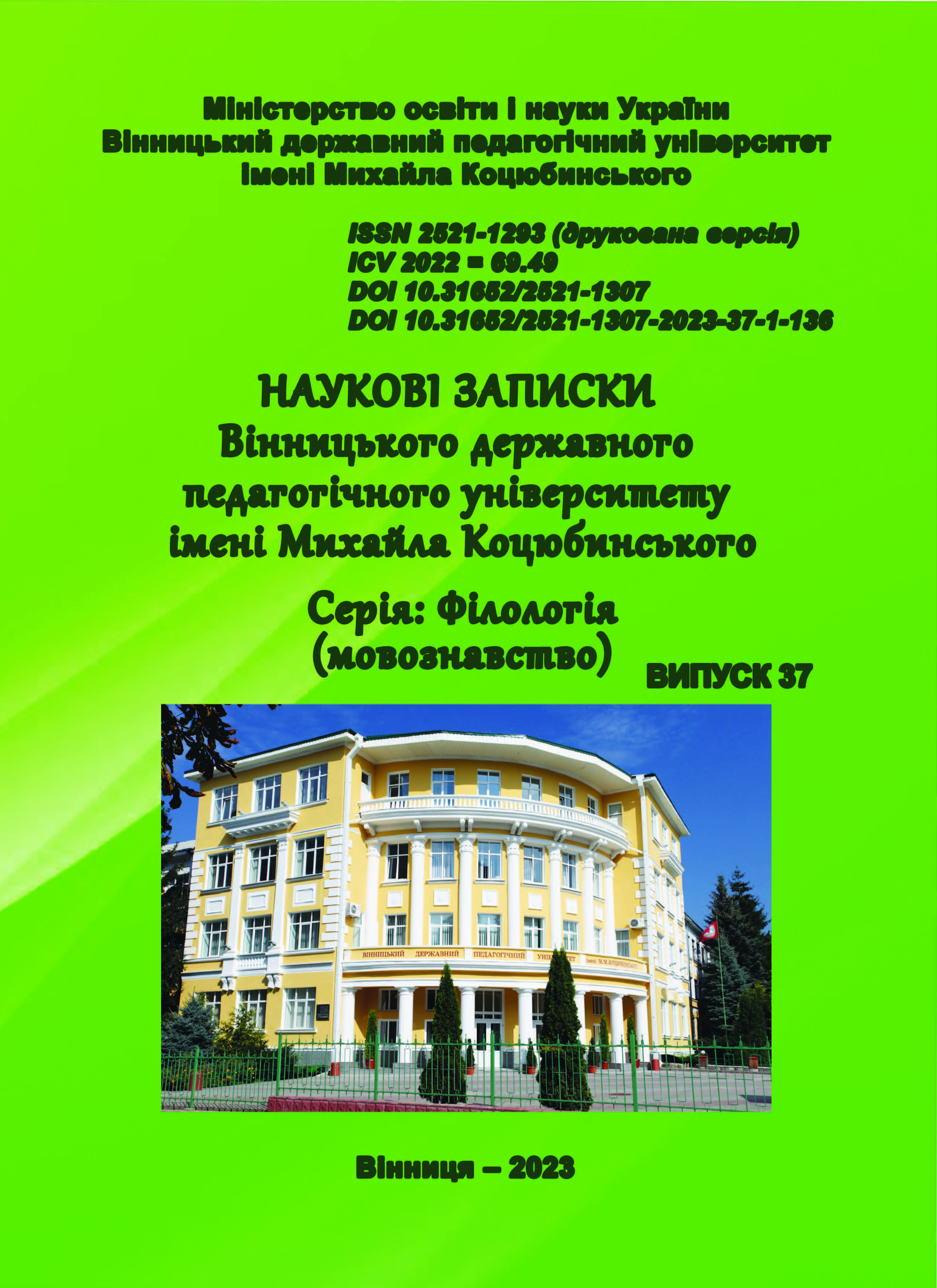Headings of prose for children: syntactic structure and communicative-pragmatic potential
https://doi.org/10.31652/2521-1307-2023-37-84-92Published 2023-12-20
Keywords
- syntactic unit, sentence element, simple compound/simple sentence, interrogative modality, imperative modality, affirmative/negative modality, desiderative modality, lexicon, lexical unit, semantics, intention, communicative-pragmatic potential, language of prose for children
Copyright (c) 2023 Наталія Костусяк

This work is licensed under a Creative Commons Attribution 4.0 International License.
How to Cite
Abstract
Introduction. In the contemporary scientific paradigm, the multivector study of representatives at the syntactic level has been implemented using various discursive and stylistic texts. However, the research of heading of prose for children is fragmentary. In this regard, it is perspective to describe the headings of fairy tales by V. Nestaiko, concurrently directing attention to the systematic analysis of their syntactic structure, morphological expression means, and lexical content. Equally relevant is the linguo-stylistic aspect, which, in combination, allows for the identification of the artist's style.
Purpose. The purpose of the article is to determine the syntactic specificity and outline the typology of sentence structures explicating the headings of fairy tales by V. Nestaiko, clarify their functional potential, communicative-pragmatic features, stylistic and structural parameters. The syntactic units presented in the heading complexes are characterized in terms of evaluative aspects,
emotional-expressive coloring, modality, realization of authorial intention, and with the purpose of highlighting the originality of the writer's thought and his/her skill in handling artistic language.
Methods. The objectivity of the research was ensured by employing a descriptive method, allowing for the classification and characterization of factual material based on a set of defining features. The distributive analysis method facilitated the research of title sentences in terms of their combinatory and contextual features. The comprehensive analysis was used to describe syntactic units with an emphasis on their structure, semantic, morphological, and stylistic features, intention, communicative-pragmatic potential, and modality.
Results. The studied headings are presented through several simple sentences, predominantly differing not only in structural parameters but also in emotional-expressive coloring, modality, intention, pragmatic features, and morphological expression. The author actively employs quotations – expressions of fairy tale characters that, in the context of other constructions, create stylistic contrast. The headings of the works are characterized by the presence of animal names and patronyms, as well as exclamations.
Originality. The scientific novelty of the work is determined by: 1) a detailed description of simple single-clause and compound two-clause structures, complex compound sentences, and non- clausal constructions that model headings; 2) a systematic analysis of sentence elements and their formal representatives – lexical units that have accompanying positive or negative nuances, often serving expressive functions and revealing intentional-pragmatic potential; 3) a comprehensive study of the names of fairy tales in the aspect of modal interpretation, which became a prerequisite for their examination with a focus on the real-irreal paradigmatic feature, as well as means of expressing morphological, syntactic, and lexical-grammatical modalities.
Conclusion. The heading complexes of V. Nestaiko's works are informative and structurally rich. They are expressed through syntactic units with varying structures, content, part-of-speech, emotional-evaluative, expressive, intentional, and pragmatic potential. In the headings of the writer's fairy tales, there are expressions that often have the nuances of oral spontaneous communication and implement interrogative, imperative, desiderative, affirmative/negative modal meanings, occasionally modal meanings of probability and necessity. All of this highlights the individual style of the writer.
Downloads
References
- Баган М., Заскалета В. Типологія порівняльних конструкцій за модулем порівняння (на матеріалі роману-колажу із стихій життя Дмитра Кешелі «Родаки»). Наукові записки Вінницького державного педагогічного університету імені Михайла Коцюбинського. Серія: Філологія (мовознавство). Вінниця: ТОВ фірма «Планер», 2023. Вип. 36. С. 30–40. https://doi.org/10.31652/2521-1307-2022-36-30-40
- Вихованець І. Р. Граматика української мови. Синтаксис. Київ: Либідь, 1993. 368 с.
- Горобець Р. Парцельовані конструкції в мові сучасної прози для дітей: комунікативно- прагматичний аспект. Наукові записки Вінницького державного педагогічного університету імені Михайла Коцюбинського. Серія: Філологія (мовознавство). Вінниця: ТОВ фірма «Планер», 2020. Вип. 31. С. 97–104. https://doi.org/10.31652/2521-1307-2020-31-97-104
- Завальнюк І. Синтаксичні засоби стилізації розмовності в мовотворчості Михайла Стельмаха. Наукові записки Вінницького державного педагогічного університету імені Михайла Коцюбинського. Серія: Філологія (мовознавство). Вінниця: ТОВ фірма «Планер», 2017. Вип. 24. С. 146–154. https://doi.org/10.31652/2521-1307-2017-24-146-154
- Завальнюк І. Експресивний синтаксис прози Михайла Стельмаха. Українська мова. 2012. № 3. С. 39–47.
- Конторчук Г. К., Шевчук М. В. Синтаксичні засоби емотивної експресії в казках І. Франка. Волинь – Житомирщина: історико-філологічний збірник з регіональних проблем. 2006. № 15. С. 187–195. URL : http://nbuv.gov.ua/UJRN/Vg_2006_15_30 (дата звернення: 09.10.2023).
- Костусяк Н. М. Категорія синтаксичної модальності та її грамемна реалізація. Лінгвістичні студії. 2013. Вип. 26. С. 99–103.
- Костусяк Н. М. Грамемна структура категорії лексико-граматичної модальності. Типологія та функції мовних одиниць. 2014. № 1. С. 127–139.
- Морозова Н. В. Структура та семантика складного речення в ідіостилі Євгена Гуцала (на матеріалі художньої прози) : автореф. дис. на здобуття наук. ступеня кандидата філол. наук. Київ, 2006. 18 с.
- Самойленко В. В. Функції та структура заголовків у сучасних творах для дітей. Науковий вісник Херсонського державного університету. Серія Германістика та міжкультурна комунікація. 2020. Вип. 1. С. 245–249. https://doi.org/10.32999/ksu2663-3426/2020-1-38





